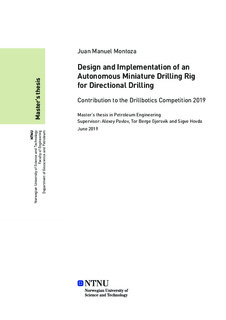| dc.contributor.advisor | Pavlov, Alexey | |
| dc.contributor.advisor | Berge Gjersvik, Tor | |
| dc.contributor.advisor | Hovda, Sigve | |
| dc.contributor.author | Montoza, Juan Manuel | |
| dc.date.accessioned | 2019-10-31T15:20:53Z | |
| dc.date.available | 2019-10-31T15:20:53Z | |
| dc.date.issued | 2019 | |
| dc.identifier.uri | http://hdl.handle.net/11250/2625933 | |
| dc.description.abstract | Denne rapporten viser arbeidet gjort av NTNU-laget under andre fase av Drillbotics. Drillbotics er ein internasjonal borekonkurranse som blir arrangert av DSATS for femte a ̊r pa ̊ rad i 2019, der universitetsstudentar vert utfordra til a ̊ bygga og automatisera ein miniatyrborerigg. Kvart a ̊r blir ei ny utfordring introdusert, og fokuset dette a ̊ret er pa ̊ nedihullsma ̊lingar og automatisering av retningsboring.
I fyrste fase av konkurransen vart eit designforlag presentert for korleis hovudutfordringane skulle taklast [35]. Dette designet presenterte to ulike mekaniske alternativ for a ̊ oppna ̊ ret- ningsboring ut fra ̊ nedihullsma ̊lingar.
Fleire endringar ma ̊tte gjerast pa ̊ riggen for a ̊ gjera retningsboring mulig. Top-drive- motoren ma ̊tte byttast ut for a ̊ mogeleggjera presis styring av nedihullsutstyret, og leidningane inne i borestrengen ma ̊tte forbetrast og gjerast mindre for a ̊ ha stabil kopling med nedihulls sensorkort. Ei ny pumpe ma ̊tte monterast for a ̊ tilfredsstilla dei høge trykk-krava fra ̊ det hydrauliske systemet.
Eit 9-akse sensorkort med akselerometer, magnetometer og gyroskop har blitt brukt for a ̊ ma ̊la brønnbanen. Ein elektromagnet har blitt brukt for a ̊ gjera opp for magnetisk forstyrring i nærleiken av magnetometeret. Denne løysinga gjer det enklare for sensoren a ̊ ma ̊la magnetisk nord, og det blir difor enklare a ̊ bora brønnen i ønska retning.
Kontrollsystemet er implementert i NI LabVIEW, og inneheld fleire nye funksjonalitetar. Eit forbetra grafisk brukargrensesnitt hjelper operatør med a ̊ visualisera og tolka det som forega ̊r i brønnen ved bruk av eit live loggpanel. HMS har blitt styrka, og nedetid redusert, ved innføring av ein tryggleikssekvens som blir aktivert av mindre advarslar fra ̊ systemet, og jobbar for a ̊ redusera problemet før det blir sa ̊ stort at riggen ma ̊ stoppast.
Fleire utfordringar og begrensningar vart møtt under prosjektet. A ̊ laga nedihullsutstyr i miniatyr fra ̊ grunnen av fører med seg mange praktiske utfordringar som ma ̊ forsta ̊ast og løysast. Dette aspektet av prosjektet, samt det laget lærte av utfordringane, er skildra og forklart i rapporten.
Konkurransen for Drillbotics 2019 blir haldt 13. juni i Celle i Tyskland. Alle finalistane fra ̊ Europa skal delta her, og starta boringa samtidig. Sidan leveringsfristen til oppga ̊va er før konkurransedagen, vil denne rapporten ikkje innehalda NTNU sine resultat i denne konkurransen. | |
| dc.description.abstract | The current report will showcase the work done by the NTNU team during Phase II of Drillbotics. Drillbotics is an international drilling competition organized by DSATS for the fifth consecutive year that challenges university students to build and automate a miniature drilling rig. Each year a different challenge is introduced and autonomous directional drilling and downhole measurements are the main focus of this year’s competition.
During Phase I of the competition, a design proposal was presented to tackle the main challenges [35]. Such a design serves as a starting point for the current work and will focus on implementing two different mechanical alternatives to deviate the well while taking downhole measurements.
Several changes had to be made to the rig to be able to deviate the well. The top drive had to be changed to be able to steer the BHA precisely and the wiring inside the drill string had to be optimized and shrunk to be able to have a stable connection with the downhole sensor card. Besides, a new pump had to be installed in order to fulfill the high-pressure requirements in the hydraulic system.
A 9-axis sensor card which includes an accelerometer, magnetometer, and a gyroscope has been used to track the trajectory of the well and as feedback for the control system. An active magnetic ranging method has been implemented to overcome the magnetic disturbances in the vicinity of the magnetometer. This solution helps keeping better track of the magnetic North and thus, the direction of the well.
This year’s control system is implemented using NI LabVIEW and includes numerous new features. A better GUI helps the driller visualize and interpret what is going on in the well through a live log panel. The script also increases HSE by including a safety sequence that automatically takes control over the rig and prevent a complete rig halt should any dysfunction appear.
Many challenges and limitations were encountered along the way. Manufacturing miniature downhole tools from scratch comes with a lot of practicalities that need to be understood and overcome. These aspects are included and thoroughly explained in the report, as well as the lessons learned.
The competition day for Drillbotics 2019 will be held on June 13th in Celle, Germany. All the finalists from Europe will compete and start drilling at the same time. Due to deadline limitations, this report could not include the NTNU rig performance in the competition. | |
| dc.language | eng | |
| dc.publisher | NTNU | |
| dc.title | Design and Implementation of an Autonomous Miniature Drilling Rig for Directional Drilling | |
| dc.type | Master thesis | |
